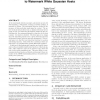Free Online Productivity Tools
i2Speak
i2Symbol
i2OCR
iTex2Img
iWeb2Print
iWeb2Shot
i2Type
iPdf2Split
iPdf2Merge
i2Bopomofo
i2Arabic
i2Style
i2Image
i2PDF
iLatex2Rtf
Sci2ools
MMSEC
2006
ACM
2006
ACM
Hermite polynomials as provably good functions to watermark white gaussian hosts
In the watermark detection scenario, also known as zero-bit watermarking, a watermark, carrying no hidden message, is inserted in content. The watermark detector checks for the presence of this particular weak signal in content. The article looks at this problem from a classical detection theory point of view, but with side information enabled at the embedding side: the watermark signal is a function of the host content. Our study is twofold. The first issue is to design the best embedding function for a given detection function (a Neyman-Pearson detector structure is assumed). The second issue is to find the best detection function for a given embedding function. This yields two conditions, which are mixed into one ‘fundamental’ partial differential equation. Solutions of this fundamental equation are heavily dependent on the probability distribution function of the host signals. This conference paper is an extract of [7], where we only look at white gaussian hosts. This gives...
| Added | 14 Jun 2010 |
| Updated | 14 Jun 2010 |
| Type | Conference |
| Year | 2006 |
| Where | MMSEC |
| Authors | Teddy Furon |
Comments (0)

